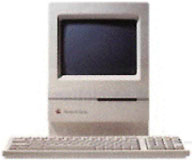Hello everyone, thanks for tuning in.
For the last week or so, I've been setting up a number of my
machines for use in my "30 Days of Old School Computing" project.
This article focuses on one of those machines, a Classic II.
A week ago, I decided to set up my old Classic II, because I
have always had fond memories of using Classic IIs back in
elementary school.
Limited Space
I knew it was going to be a tight squeeze, because it only had a
40 MB hard drive. I had WannaBe, MacLynx, Eudora Lite 1.3.1, Word,
Excel, Kid Pix, and a bunch of games like Brickles and PacMan
installed, and then I ran out of room. I really wanted to install
AIM (AOL's Instant Messenger program), but I didn't have enough
room on the hard drive.
I have a box of old SCSI and IDE hard drives, so I dug out the
smallest SCSI drive I could find (a 230 MB drive) and an external
case for it. I hooked up the external drive, and booted the Classic
II.
No good, the drive wouldn't mount.
A Bad Disk Tools Floppy
Okay, time to dig up the old System 7.1 disks I have somewhere.
I found my old Disk Tools disk, but when I put it in the drive, I
got the dreaded message: "This disk is unreadable: Do you want to
initialize it?"
 "Great", I thought "Now I have a bad Disk Tools
disk."
"Great", I thought "Now I have a bad Disk Tools
disk."
I decided to Initialize it and then go on Apple's archived
software site and download System 7.1. Uh oh, you can't get System
7.1 from Apple's site, but you can get System 7.0 and 7.0.1.
"Fine", I said to myself. I downloaded it and put the System
7.0.1 Disk Tools on my old Disk Tools floppy.
Still No External Drive
I opened the Apple HD SC setup utility, and it didn't see
external the drive. Maybe the external drive box is messing up?
So I opened the Classic II, took out the old drive - and guess
what I found? Both drives were set to the same SCSI ID. (For those
who don't remember SCSI, each device has to have a unique ID or you
get problems like this.)
Stupid me, I should have thought of that. Both drives had been
internal ones.
Since I already had to old drive out, I decided to change the
SCSI ID on the new drive and install it in the Classic II.
Well, I got it back together again, turned it on, and realized
I'd made a big mistake. I had set the drive to disable auto spin up
- now I had to take the whole machine apart again and terminate a
different jumper.
It Finally Works!
I'd wasted enough time. I put it back together again, put in the
Installer floppy for System 7.1, and waited for it to boot.
As soon as it started to open the installer, I got the following
message: "The Installer needs more memory to perform an
installation. Try quitting other applications and running the
Installer again. You could also try removing some system extensions
and restarting to make more memory available."
I was getting a little ticked off. How could there not be enough
memory? The system was booting off the installer disk, and the
machine had 10 MB of RAM!
I put the old internal hard drive in the external case and
hooked it up the the Classic II. I decided to boot off of the Disk
Tools floppy and just copy all of the stuff on the old hard drive
to the new one.
AIM on the Classic II Is Very Slow
That worked, and the computer booted off the new internal drive.
With the new hard drive installed, I was able to transfer the AIM
installer onto the Classic II and install AIM.
I knew I was going to have to import all of my buddies onto AIM
manually, because versions before 4.3.1 don't pull your buddies off
of the AIM server.
It would have taken well over half an hour to do that on the
Classic II, because every time you hit the return key (after you
type in a new buddy) on the Classic II, there was a 40 second
delay. I don't know why there was such a long delay, but that
didn't matter. I didn't want to wait.
So I installed AIM 3 on my old Power Mac G3, typed in each of my
buddies, and copied the AOL Instant Messenger preferences file over
the network into my Classic II's Preferences folder. It worked
great, now I was able to Instant Message all of my friends.
I'm looking forward to hearing your thoughts on this project, so
please feel free to email me. 
Next time: A talk with a manger at McDonald's
leads to a partnership in old school computing.

 "Great", I thought "Now I have a bad Disk Tools
disk."
"Great", I thought "Now I have a bad Disk Tools
disk."
